Table of Contents
The first listing on a search engine results page (SERP) earns nearly a third of all clicks for a given search term. Luckily, search engines display a combination of paid advertisements and organic search results, giving brands with varying marketing budgets the opportunity to appear on the first page.
These paid placements, known as “search ads” or “PPC ads,” make up one-half of a strategy known as search engine marketing, or SEM. The other half is search engine optimization, or SEO, which focuses on organic methods of driving traffic. Together, SEO and PPC make SEM.
Still, in the world of digital marketing, SEO and SEM are often used interchangeably. But they’re two distinct approaches for boosting web traffic. Complicating things further, some businesses use the term “SEM” to refer just to paid search ads. But this isn’t the case.
The SEO vs SEM debate centers around whether brands are using paid ads, SEO techniques, or a combination of both to achieve results. To make this comparison, it’s important to know the key ingredients of each marketing strategy and what type of results they produce. Today, we clear up some definitions, differences, costs, and help you determine when you should use each.
SEO vs SEM: A definition
SEO is an organic search strategy that helps websites appear higher on SERPs. This approach increases organic traffic by making website content and code more valuable to both users and crawlers on Google, Yahoo, and Bing.
On the other end is pay-per-click (PPC), a paid search strategy that involves buying listing space on SERPs. Unlike SEO, which focuses on a long-term marketing impact, PPC campaigns run for a finite amount of time: until you stop them or you run out of budget.
Together, SEO and PPC are the two halves of an SEM marketing strategy.
SEO vs SEM: The basics
To understand the full scope of SEM, it’s helpful to understand the three pillars of SEO and how they influence a website’s performance on results pages. SEO practices are part of a long-term strategy that grows more powerful with time.
SEO Basics
Generating website traffic through organic search results is a digital marketing strategy that relies on proven SEO methods. There are three main pillars of SEO you can turn to in order to increase your site’s rankings.
The three pillars of SEO are: on-page SEO, off-page SEO, and technical SEO. Together, they form a comprehensive SEO marketing strategy that can boost page views and improve the entire website’s overall search engine performance.
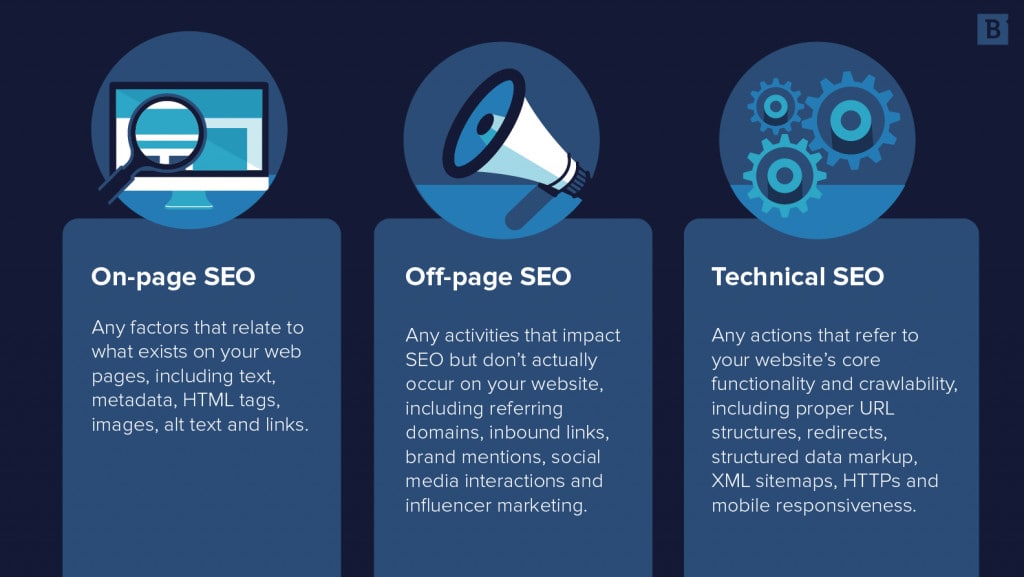
Each pillar influences a specific area of the brand’s online presence, ensuring that your website is optimized on the deepest level possible.
On-page SEO
On-page SEO is the optimization of content and metadata on your own website, the areas of pages that users see and interact with. This is the best area to establish the focus topic of your web pages and to make sure that crawlers can accurately categorize your website.
There are many on-page SEO techniques that you can implement, but these are some of the most important:
- Internally linking content
- Enhancing images (size, alt text, etc.)
- Providing high-quality content
- Writing attention-grabbing title tags and meta descriptions
- Answering search queries
- Conducting keyword research
On-page SEO techniques are the most commonly used because they’re simple enough for beginners, and because, arguably, there is no more important pillar of SEO than on-page SEO.
Off-page SEO
SEO strategies that happen off your website (i.e on social media accounts, other brands’ web pages, etc.) are referred to as off-page SEO techniques. This branch of SEO is designed to generate backlinks to your website (links from other pages to your content).
Off-page SEO includes strategies like link building, guest blogging, using social media marketing techniques, and more. Backlinks, which are like upvotes to Google, are essential for building credibility in your industry. The more you earn from quality sources, the more Google considers you a trustworthy source of information, and rewards you by improving your search engine rank.
Technical SEO
The technical SEO pillar refers to all of the behind-the-scenes website optimization tactics that can improve your overall site performance and positively impact the indexing process. While users can’t see these optimizations, they can experience them, for example, in an improvement in page load time.
Search engine crawlers read and index the content, code, and data files that you store in the back-end of your web pages.
Having keyword-relevant data, efficiently-stored files, and optimized code can provide even more context to crawlers who need to categorize the information on visible pages. Technical SEO strategies include:
- Optimizing page speed
- Canonicalizing duplicate content
- Creating a simple site structure
- Enabling HTTPS encryption
- Submitting an XML sitemap
- Generating rich snippets with structured data markup
These strategies focus on data optimization and user-experience technical attributes like site speed and structure. Technical SEO helps boost website traffic because it ensures that the site performs as efficiently as possible while giving crawlers more clues to the content’s focus topic.
SEM Basics
All of the previously mentioned SEO techniques are part of a strong SEM strategy. In addition to these techniques, marketers also use PPC ad campaigns to improve their brand’s performance in Google search results.
Like SEO, PPC also has many components. Following these PPC best practices will ensure that your paid ads deliver results, but unlike SEO practices, they cost money to implement.
Bidding
Before your paid ads will appear on a SERP, you have to bid on the keyword that you want them to target. Your bid represents the amount you’re willing to pay every time someone clicks on your ad, an amount known as the “cost per click” (CPC).
Google Adwords is the most popular PPC platform where you can bid for keywords with competing sites. Searchers will see ads from the brands who bid the most for their search terms.
Keywords
For PPC ads to be effective, they have to target words and phrases that people are searching for online. If you bid on keywords with low search volume, people searching for those terms might click on your ads, but the ad still won’t reach enough people to grow your business.
PPC keyword research is the best method for determining which search terms to bid on for your ad. Bidding on branded search terms is a good place to start. Examples for this would be: “starbucks coffee mug” or “converse high top sneakers.” That’s because the people searching these terms are looking specifically for your product.
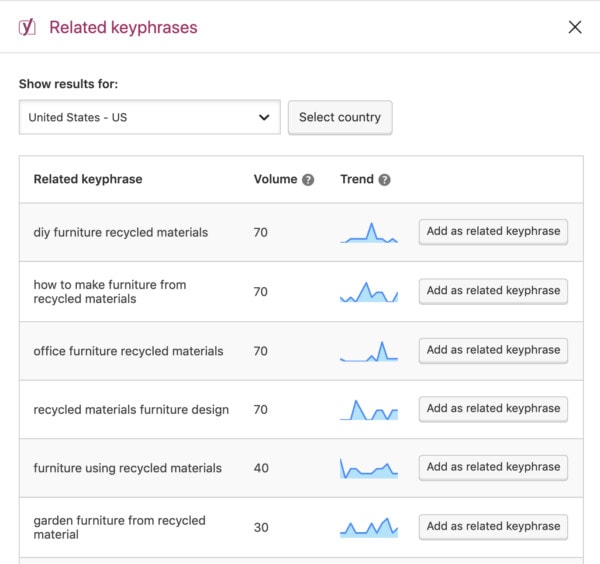
Another effective method is bidding on long-tail keywords that have less competition. These usually cost less than short-tail, high-volume search terms, but they do have the advantage of being more specific. Long-tail keywords provide you a unique opportunity to capture a niche search term in your industry.
Ad types
There are different ad types you can purchase depending on your budget, target audience, and content format. Some of these types include:
- Call-only ads
- Text ads
- Search ads
- Shopping ads
- Static image ads
- YouTube ads
The two most popular types you will see on a results page are search ads and text ads. The other options on this list typically require the user to navigate to another platform or area (think: Google’s shopping tab) to see them.
Search ads appear on the results page when a user inputs their search terms. They can display both horizontally or vertically.
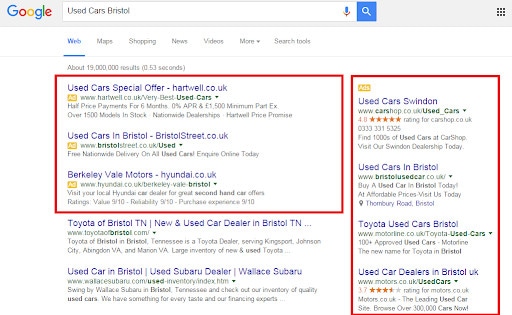
Text ads like the one below include up to 90 characters per description and show up across the Google Network.
Picking the right kind of ad for your product and audience is an important decision. Before buying PPC ads, research your keyword on the search engine and look at what ads are already there. This may give you a better idea of which type to use.
Quality score
In order to provide a top-notch ad experience for its users, Google Ads measures each ad’s value and assigns it an overall quality score. This metric considers your ad’s relevance to users, anticipated click-through rate (CTR), and landing page experience.
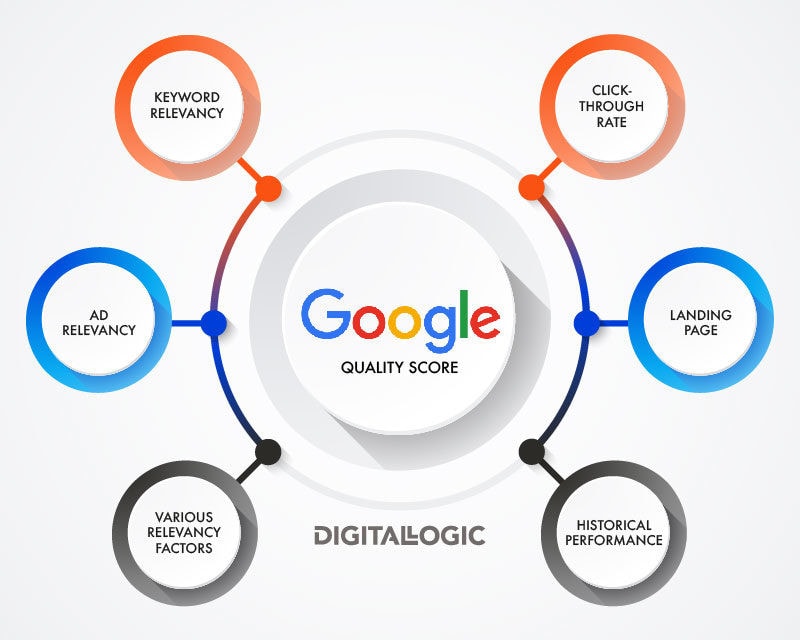
The quality score is designed to show you if your ad/keyword needs to be adjusted in order to perform better. Websites that have higher quality scores can even receive discounts on the search ad’s CPC.
Landing page experience
Your Google quality score is partially determined by the landing page experience users have when they click on your ad. Their click takes them to a URL which needs to be user-friendly, value-added, and relevant.
To ensure a great landing page experience, make sure your content is helpful and relevant, your contact information is available, and your site speed is optimal (among other things). These factors add up quickly to determine whether users trust your website or retain interest in your product or service.
Ad copy
Not only do you have to bid well and choose the right keywords, but you have to write ad copy that truly encourages people to check out your product or service.
Well-written ad copy hooks the reader and generates either curiosity or interest, both of which lead to a higher CTR. It should demonstrate how your product or service will benefit the user and include a call to action.
When to use SEO vs SEM vs PPC
Deciding which internet marketing strategy to implement is largely influenced by the search terms you’re targeting. There are different types of search intent (user search queries) that can help you determine which strategy works best for your needs.
When users make informational searches for search terms like “how to clean hiking boots,” they aren’t necessarily looking to buy anything. For these keywords, SEO is the best strategy because it gets people to your website where they can explore your brand further. Plus, it builds your brand’s online presence and orients you as more of an industry leader in the eyes of search engines.
PPC ads are better for targeting transactional search terms (where the user is looking to buy something). If someone searches for “buy hiking boots” and you’ve bid on that keyword, they may be exposed to your ad. You could also combine this approach with SEO to enhance your results.
For example, say you have a line of hiking boots and you’ve created a hiking boots buyer’s guide that ranks for “buy hiking boots,” generating impressive traffic on its own. This optimized web page can boost your conversion rate by demonstrating that you are an authority on hiking footwear. Visitors are more likely to trust the quality of your product if you showcase knowledge in your area of expertise.
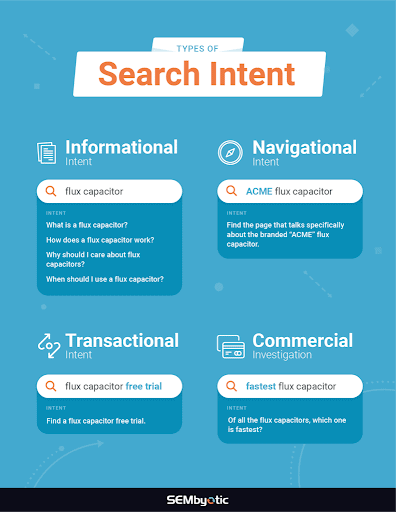
For commercial investigation search intent, where users want to learn more about a potential purchase, you could also use both strategies. Creating a “best hiking boots of 2021” web page for users while also bidding on these keywords will increase your chances of earning their business.
While user search intent can be a helpful guide for determining which approach to take, cost and time commitment are equally as important. If you are a small brand looking for short-term traffic boosts throughout the year, PPC would be the better option. This will cost money upfront but won’t require a long time commitment.
On the other hand, if you are a brand that can’t afford to compete with top-ranking brands like Amazon, Walmart, or industry-specific leaders, SEO is the way to go. What you won’t spend monetarily, you’ll spend with your time. This cost, however, can potentially lead to longer-term, scalable results.
SEO vs PPC: How much does it cost?
A PPC marketing campaign requires you to pay upfront for ranked content. Meanwhile, the cost of an SEO strategy varies significantly across brands. While some websites may do the best they can with a small marketing budget, others may pay to create high-quality, high-ranking content by:
- Hiring content writers, software engineers, or graphic designers
- Paying for CMS plugins
- Subscribing to SEO tools
- Taking SEO courses
Each website approaches SEO differently and has a different set of resources available, so it’s hard to quantify exactly how much these strategies cost. The time and resource commitment to optimize each web page means that SEO usually costs more than PPC, at least in terms of time as a tradeoff for money.
Overall, however, the long-term impact of SEO can lead to costs which ultimately pay for themselves many times over–making SEO the more cost-effective option for sustainable growth.
SEO vs PPC: How long does it take to see results?
Once your PPC campaign starts, users can see your ads straight away. While the campaign is active, clicks generate higher web traffic that can potentially increase your revenue.
While PPC can deliver nearly instant results, SEO takes longer. SEO techniques focus on creating content that search engine algorithms will rank higher, especially the longer that the content proves its value. These efforts take time, and it can take months to generate traffic for search terms on your website.
Although these results come slower, they stay longer. PPC-generated traffic stops once the campaign has ended, so these are more for short-term results, unless you continuously renew campaigns.
Get a complimentary SEO audit
So which is better, SEO or SEM?
It depends. Choosing between SEO and SEM means being realistic about your availability, marketing budget, and expectations. PPC gets instantaneous results but they only last if you have money to pour into your campaigns. SEO can cost more up-front, but it’s the most sustainable way to generate growth that can compound over time with relatively low maintenance.
Want to see how you’re doing with SEO? Get an instant SEO audit below. Or, schedule a free consultation to see how intent SEO can boost search traffic revenue by 700%.
